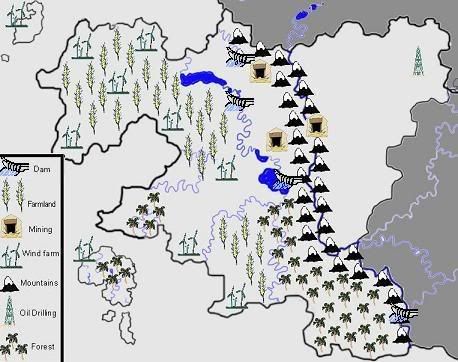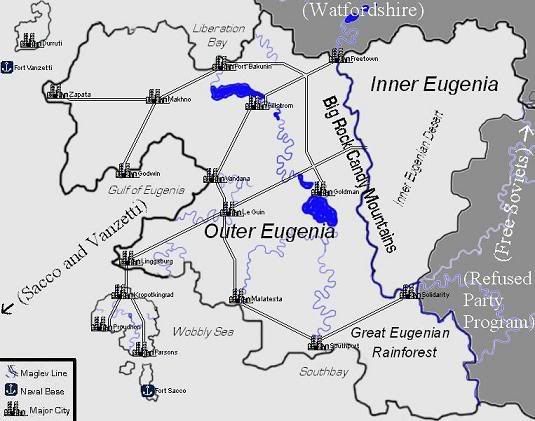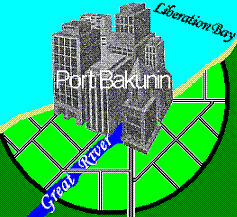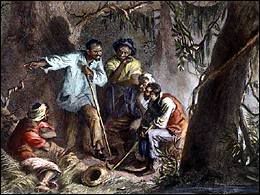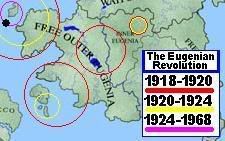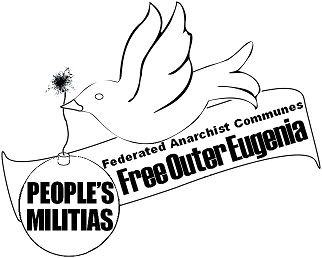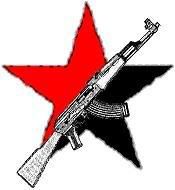Free Outer Eugenia
| |||||
| Motto: Autonomy in Organization. | |||||
| National Anthem: Big Rock Candy Mountains (unofficial) | |||||
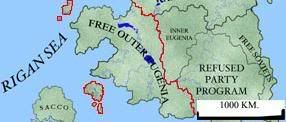
| |||||
| Region | Anarchy, Aperin | ||||
|---|---|---|---|---|---|
| Capital | None | ||||
| Largest city | Port Bakunin | ||||
| Official Language(s) | Eugenian, English, Spanish | ||||
| Government | Anarchist Federation | ||||
| - Industrial Syndicates | Rural and Urban Communes | ||||
| - Workplace Assemblies | Commune and Block Assemblies | ||||
| - Local Labor Councils | Urban Communal Councils | ||||
| - Industrial Unions | Ecoregional Congresses | ||||
| - Eugenian Federation of Workers | Federated Anarchist Communes | ||||
| Independence | The Expulsion of the Cartel | ||||
| - Liberation of Port Bakunin | May 1, 1917 | ||||
| - Establishment of the FAC | February 15, 1918 | ||||
| - The Fall of Ft. Carnegie | Nov 22, 1924 | ||||
| - The Fall of Ft. Vanderbilt | May 5, 1968 | ||||
| Population | 60-70 million | ||||
| Currency | None (mutual aid economy) | ||||
| NS Sunset XML | |||||
The UN inspectors also noted that the level of political freedom in the Federated Anarchist Communes is 'superb,' and they actually found the personal freedoms enjoyed by Outer Eugenians 'frightening.' They described the economy as 'very strong' and noted that crime is 'totally unknown' in Free Outer Eugenia.
Contents
The Lay of the Land
The Federated Anarchist Communes of Free Outer Eugenia are located in the Anarchist south of the continent of Lesser Aperin. Outer Eugenia is the southern neighbor of Watfordshire and it lies west of Inner Eugenia and the communes of the Refused Party Program. Outer Eugenia's southern coast borders the Alçaerin Ocean and it's northern and western coasts are on the Rigan Sea. The islands of Sacco and Vanzetti lie 600 kilometers southwest from Outer Eugenia's shore. The Outer Eugenian climate is subtropical and it's most notable geographical features are the Big Rock Candy Mountains that mark Outer Eugenia's western frontier and the Great Eugenian Rain Forest in the south.
Agriculture
All of Free Outer Eugenia's population centers are 'green cities.' Roof gardens, street orchards and community parks produce a good portion of the urban food supply. There is also however a rich and sparsely populated countryside whose population is chiefly devoted to sustainable agriculture and fishing. They work the land and harvest the sea's bounty in order to bring forth the various grains, fruits, vegetables and fish that are the staples of the Outer Eugenian diet. Their output not only supplements urban food production but also provides for Eugenian food exports.
|
|
|---|
| Natural Resources and Land Use in Free Outer Eugenia |
Environment and Energy
Because of it's sustainable energy and transportation infrastructure as well as a commitment to polyculture-based farming, Free Outer Eugenia has made great strides toward healing from the ecological disaster of the colonial period. The Great Eugenian Rain Forest and the mountain ecosystems have been thriving in recent decades and the "punkass dove" population has reached pre-colonial levels. Most of the electricity in Free Outer Eugenia comes from high performance wind, solar, tidal, hydroelectric and geothermal plants. Biodiesel and bio-gas are Outer Eugenia's fuels of choice.
Inner Eugenia
Inner Eugenia is a vast sandy desert east of the Big Rock Candy Mountains. It is populated by a number of nomadic tribes as well as several small communes. The tribes and communes of Inner Eugenia enjoy friendly relations with the Outer Eugenian Federation, and allow it full access to Inner Eugenia's plentiful oil reserves in exchange for the various fruits of Outer Eugenian industry and agriculture. Outer Eugenians use very little of this precious resource for fuel. A vast majority of the petroleum used by the Federated Anarchist Communes is utilized in the manufacture of advanced lubricants and plastics which are carefully recycled. The oil is transported through the Pan-Eugenian Pipeline that was originally laid during the later decades of Eugenia's colonial period.
Life in Free Outer Eugenia
Free Outer Eugenia's culture is an ecumenical fusion of native Eugenian ways with the various traditions that were brought over during the colonial period. In recent decades, increased interaction with the various peoples of Aperin and Alçaera has added to the cultural mix. Outer Eugenians are generally a peaceful and easygoing people. They tend to be very informal and are violently intolerant of hierarchy and bureaucracy. Eugenians like to live with a reasonable level of comfort, but they don't like to work too hard and generally value leisure time over a more opulent lifestyle. The institution of marriage is unheard of- Eugenians practice free love. It's expression ranges from polyamory to lifelong monogamous companionship and Outer Eugenian children are generally raised by the entire community.
The native Eugenian language has no words for the concept of "ownership." In Eugenian, the relationships between people and inanimate objects are described in terms of "need" and "use." So the closest Eugenian translation of the phrase "this is my pen" would be "this is the pen that I am using."
Urban Communes
|
|
|---|
| The Urban Communes and the Eugenian Maglev System |
Each of Outer Eugenia's seventeen Urban Communes is a vital cultural center. These green cites were designed by master architects with sustainability, convenience and beauty in mind. Their walls are covered with murals and their wide streets and gardens (the distinction between the two is almost non-existent) are filled with music and sculpture. As Outer Eugenia's anarchist economy has eliminated unnecessary industries and largely automated many of the essential ones, the people of the Federated Anarchist Communes are free to spend most of their lives creating and appreciating beautiful and interesting things.
Village Communes
While most of the Federation's people reside in the cities, some prefer to live in the more bucolic setting of the Outer Eugenian countryside. Rural Eugenians tend to be more spiritual and reflective than their urban comrades and their art and literature is a testament to this- it's general ethos evokes elements of Zen Buddhism, native Eugenian spirituality, as well as Sufi traditions. They tend to rely less on modern technology and feel themselves to be closer to the earth.
Outer Eugenian Nomads
The "Wandering Vagabond Caravans of Outer Eugenian Nomads" is a confederation of several small nomadic groups whose range extends from the Outer Eugenian foothills of the Big Rock Candy Mountains to the outskirts of the Inner Eugenian Desert. They are the only constituency within the Federated Anarchist Communes that still maintains United Nations membership.
Transport
The major population and industrial centers of Free Outer Eugenia are connected with magnetic levitation train lines. The maglev system allows quick and energy-efficient movement of people and resources with minimal environmental impact. Though the local maglev networks for longer trips within the cities, the Urban Communes were built with walking and cycling in mind. There are some hybrid (electric/biodiesel) vehicles available for general use in the cities, but most of them are reserved for emergency services. Most residents of the rural areas travel by burro and mule when moving between village communes as a matter of preference, but use electric/biodiesel vehicles when it is convenient to do so.
|
|
|---|
Education
Education in Free Outer Eugenia is a lifelong process, though there are no schools or universities in the conventional sense. Everyone in the Federation is both teacher and student. Every commune has various open educational collectives where all sorts of skills are shared. The largest and most famous of these is the Francisco Ferrer University Collective at Port Bakunin. All Outer Eugenians have some training in both the arts and essential labor functions as well as various forms of personal defense and guerrilla warfare. Outer Eugenians are generally fluent in four or five languages. The Federation has no official language though Eugenian, English, and Spanish are spoken by most.
Media
Each commune has it's own local print and broadcast collectives and internet access is universally available . Outer Eugenian media is worker-controlled and serves as a free and open forum for everyone in the community. The best of Outer Eugenian broadcasting is syndicated on a federation-wide and international level by FOEnet
History
The Old Eugenian Empire and the Age of Peace
|
|
|---|
| Temple ruins near Southport |
The great stone temples and palaces of what archaeologists believe to have been a vast theocratic bronze-age empire were suddenly abandoned in 1583 BC. According to the Old Eugenian Empire's own astrological charts, this was the year that the world was supposed to end. The monuments themselves tell gruesome tales of mass human sacrifices that were preformed to bring in the Fifth Age and the terrible wars that were waged to appease the bloodlust of the Gods. According to the ancient Eugenian epic, The Lay of the God-King, the people of the Old Empire simply and unceremoniously abandoned their priests and temples en masse when the world did not come to an end on the appointed date and they realized that they were fundamentally mistaken about the nature of the universe.
If history can be said to be defined as a series of wars, famines, dynasties and other such 'eventful' misfortunes, then the people of Eugenia enjoyed a three thousand year historical hiatus which lasted until the colonial period. This was a time of peace and prosperity for Eugenia and though plenty of written records exist from this period, none of them are particularly interesting.
Colonial Eugenia and the Cartel
Eugenia's first contact with a people that deemed the native Eugenian communalist subsistence culture to be 'primitive' occurred sometime in the 1540's. What followed was the usual pattern of false promises, greed, genocide and domination. The visitors brought empty treaties, smallpox laden blankets and square-jawed Jesuits who marched across the land with bible in one hand and sword in the other. Many Eugenians fell victim to the strange diseases that they brought. Many others died defending their land. Some retreated into the jungles, mountains and vast wastelands of Eugenia to take up a guerrilla war for land and liberty that would last for over 300 years. These freedom fighters were joined by bands of escaped slaves who were brought over from Africa to build and work the plantations that had been set up by the colonists.
|
|
|---|
| Escaped slaves meet native Eugenian insurgents in the jungle |
As the stars of various imperial powers rose and fell, the old Spaniards were displaced by other masters but not much changed until the long sought after source of the gems used in Native Eugenian jewelry was found in the Big Rock Candy Mountains. It was then that the Scramble For Eugenia began in earnest. Many bitter wars were fought amongst the world's imperial powers, and a Free Outer Eugenian Republic was formed by rebel peasants, native insurgents and the various slave revolts in the ensuing chaos. The Free Republic lasted for the better part of a decade until the powers contending for control over Eugenia's resources came to an uneasy compromise. A 100-year monopoly over Eugenia was granted to an international cartel led by the notorious patent medicine conman turned railroad tycoon and beef magnate Augustus Kroc. Kroc then sent his ambitious son-in-law Tiberius at the head of a mercenary army to take possession of his monopoly.
Faced with the ironclads, Gatling guns and other superior arms of an industrial war machine, the machete and musket wielding defenders of the Free Republic were brutally crushed. The rich planters who had fled Eugenia returned to their estates as another generation of freedom fighters retreated into the mountains and jungles.
Acting as an agent of Kroc Industrial, Tiberius Kroc (who had taken his father-in-law's name) employed slaves and indentured laborers to mine Eugenia's gems. In response to the mass international outcry over the conduct of the invasion, he set up a sham republic with it's capitol in New Krocsport. This quickly became known as "the Cartel's Republic" or simply "the Cartel." As slavery fell out of favor in the world and early trade union movements began to win rights for waged labor, Kroc Industrial saw Eugenia as a lawless haven for the employment of slaves and waged semi-slaves to produce cheap goods for the world market. The discovery of oil in Inner Eugenia and heavy metal deposits in the Big Rock Candy Mountains further spurred KI to develop Eugenia. Tiberius Kroc (who had become the head of KI after the death of his father-in-law) negotiated a 100 year extension on KI's monopoly and moved his corporate headquarters to a fortified base on Vanderbilt Island. He imported masses of impoverished workers to fuel the industrial machine of his corporate fiefdom. With them was brought the germ of revolutionary syndicalism and anarchism. These, along with the native communalist tradition and the African slaves' bitter struggle for liberty were the ideological seeds of Eugenia's ultimate liberation.
Revolution and Liberation
|
|
|---|
| The Cartel's shrinking zone of control |
The Eugenian Revolution began on May 1, 1917 when the workers of New Krocsport and a group of their Shiree comrades expelled the Cartel from the city. The revolution continued for the next fifty years until the whole of Eugenia had thrown off the yoke of corporate imperialism, though the old regime had been largely contained in a diminishing sphere of control around Fort Vanderbilt for forty-four years. The Federated Anarchist Communes were established in 1918, and by 1920 most of the Outer Eugenian mainland was under the workers' control.
The revolution was fueled by a fusion of an underground syndicalist labor union that had formed during the years of industrialization and the native and slave uprisings that had been raging since the early years of colonization. The traditional consensus-based collectivism of the Native Eugenians and the anarchist syndicalism of the EFW formed the foundation of the post-revolutionary order.
The Eugenian Social Revolution spread across the region giving rise to the Anarchist Federation of Free Soviets, the communes of the Refused Party Program and the libertarian socialist order of the islands now known as Sacco and Vanzetti.
Economic, Political and Social Order
The Federation has never been a true 'government' but rather a free and ultimately democratic partnership of individual communes and productive associations. It has provided a structure that eradicates the perceived need to maintain order through an imposed hierarchy. Through the Federation the people of Free Outer Eugenia have made sure so that no individual or group could garner enough power to impose tyranny over the land and the people.
Political Organization
The primary structural principles of the Federation are federalism, Syndicalism, bottom-up rule, consensus based decision-making, and free association or 'the right of secession.'
- The Federation is ruled from the bottom up by the people who make up the productive associations and communes which in turn make up Ecoregions and Industries which are united under the Federation. The constituent organizations send their elected delegates to the Federal bodies.
- The delegates may be recalled at any time and are only empowered to relay the decisions made by their constituencies to a convention of delegates with similar mandates. All resolutions made within a body of delegates are sent directly to the various constituencies for final approval, rejection or amendment.
- Associations working in the same industrial line of production form Industrial Syndicates within the Federation. Immediately interdependent productive associations are structurally organized for particularly close and streamlined cooperation within each Syndicate. All Syndicates also cooperate closely with one another and many productive associations (especially those involved in the procurement and processing of raw materials) are active in several Syndicates at once. The lines differentiating the Syndicates are never straight or clear- the Syndicalist structure is an organic one based only on expediency, egalitarianism and free association. The Transportation Communication and Distribution Workers' Union is a particularly extreme case. A long heated and pedantic scholarly debate at the Ferrer University about whether the TCDU is indeed a Syndicate, or just a byproduct of the constant stream of associations between the Syndicates was laid to rest by an exclamation made by a bewildered first-year student: "But that's the same damned thing!"
- Decisions on all levels of the Federation- from the election of a delegate to the approval of a production plan- are made by consensus.
- All bodies- from a Sunday pear-picking collective in Freetown to the Federation itself- are formed and maintained by the free association of individuals and communities. No association is bound by anything but the wills and necessities of the individuals that comprise it. Eugenians find that these free and natural associations are stronger and more productive than any externally imposed structure.
Economic Organization
Any Free Outer Eugenian productive association is entitled to the right to direct and control its production and to dispose of the fruits of its labor as the workers see fit. This has made all attempts to impose hierarchical and coercive economic systems on the people of Free Outer Eugenia utterly futile.
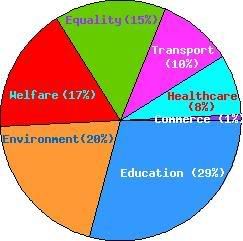
|
|---|
Every adult (The definition of adulthood varies from commune to commune. The threshold generally lies somewhere between the age of fifteen and eighteen.) member of Free Outer Eugenian society participates in several of the many that are activities absolutely necessary to run the essential industrial, agricultural and infrastructural systems of the Federated Anarchist Communes. This generally amounts to an average fifteen-hour workweek. The people of Free Outer Eugenia spend the rest of their time studying various fields of personal interest, engaging in many sorts of creative labor and generally enjoying all that a free, comfortable and stimulating life has to offer.
As the Federation economy functions on a mutual aid basis, the production plans of the workers' associations are informed by the needs of other productive associations and the communes. Though the educated opinions of various experts and academic collectives are often taken into consideration by the productive associations and communes, these learned savants act only in an advisory capacity. The economy of the Federation is certainly not centralized, but it is both planned and non-competitive.
Resource and Labor Distribution
This is a graphical representation of the Federation's general economic priorities. It has been specifically designed to fit the several standard UN categories of 'government spending.' As Free Outer Eugenia has neither a government nor a cash economy, the percentages indicate approximate assessments of the distribution of the Federation's resources and labor power. The various forms of industrial, agricultural and energy production are divided between 'Environment' 'Social Welfare' and 'Social Equality.'
Exports
The Federated Anarchist Communes participate in the CACE and IFTA, and only trade with fellow signatories. Most of Free Outer Eugenia's exports are cultural products such as music, software, beer, literature, fine art and craft items . The Federation also exports certain choice agricultural and mass-manufactured products and a small amount of copper, zinc and gems.
The People's Militias
|
|
|---|
Free Outer Eugenia has no standing army- the gains of the revolution are defended by a confederation of local militias. These militias function much like the rest of Free Outer Eugenian society: there are no officers and discipline is self imposed. Combat leadership and coordination roles are preformed by delegates who are elected by consensus. Though there hasn't been an immediate military threat to Eugenian freedom since the fall of Fort Vanderbilt in 1968, every member of the Federation over the age of 15 receives militia training.
|
|
|---|
International Brigades
The International Brigades are collectives within the People's Militias that provide assistance to various workers' struggles outside of Free Outer Eugenia. They are generally experienced in various forms of guerrilla warfare, street fighting and industrial sabotage. They are also well trained in the arts of camouflage and are easily able to blend into the landscape or into a crowd. The history, tactics and ideology of the International Brigades are described in their defacto manual "We Are Winning" by "Red Shadow" Rabinovitz. The International Brigades are much admired by their fellow Outer Eugenians and are the subjects of many songs, poems and murals.
Coast Guard
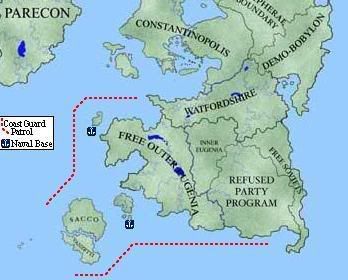
|
|---|
The People's Militias conduct regular patrols of the Outer Eugenian coast. These patrols are based in Fort Sacco and Fort Vanzetti, Free Outer Eugenia's two fortified naval bases. Though there hasn't been an attempted sea invasion of the Federated Anarchist Communes since Revolutionary times, the people of Free Outer Eugenia maintain their vigilance. Some have suggested that this is mostly because they really like riding around in little boats.


